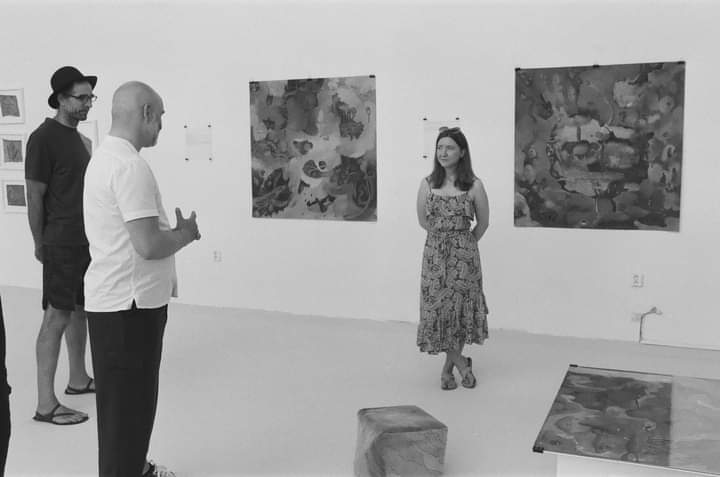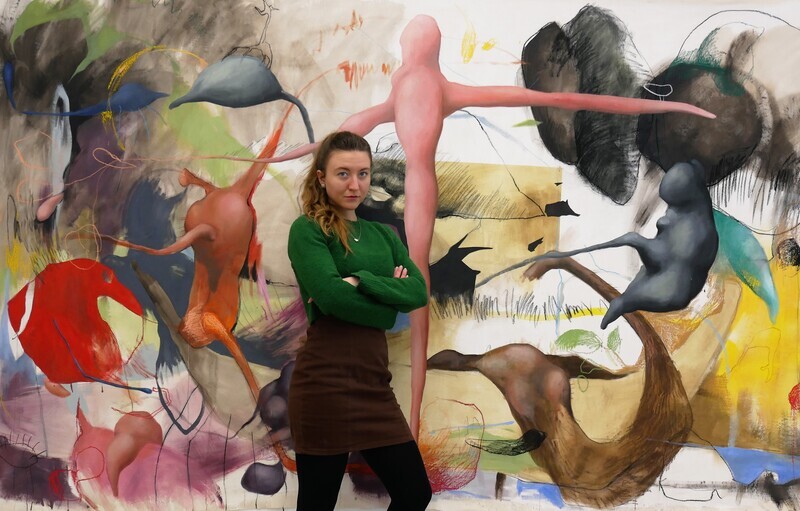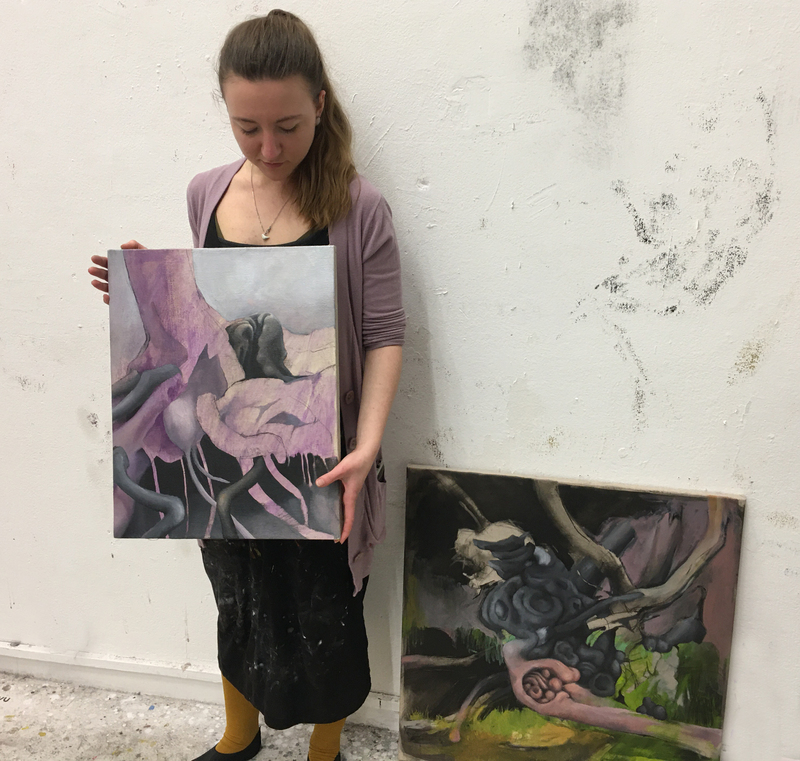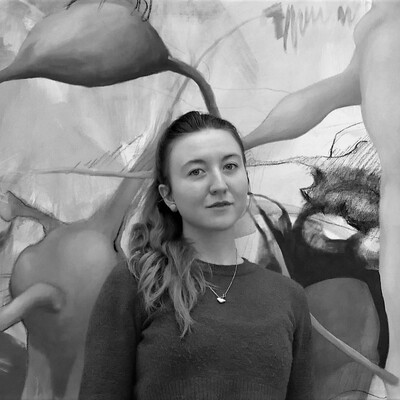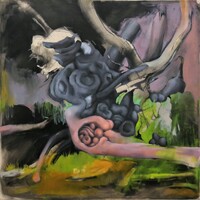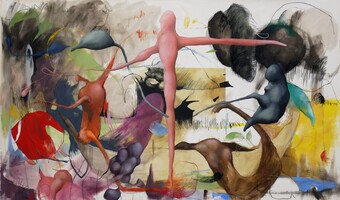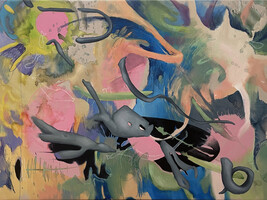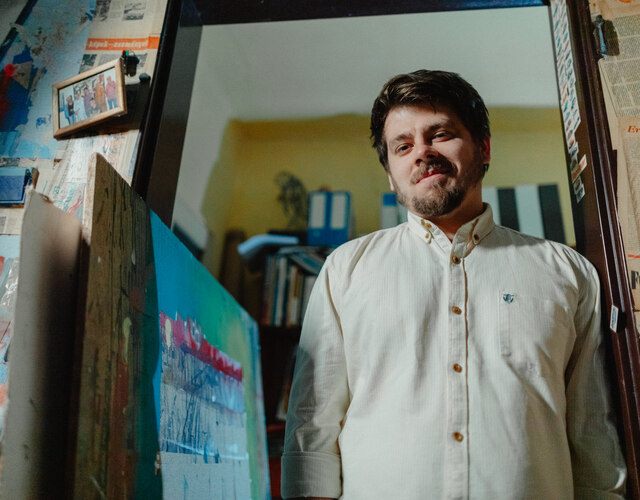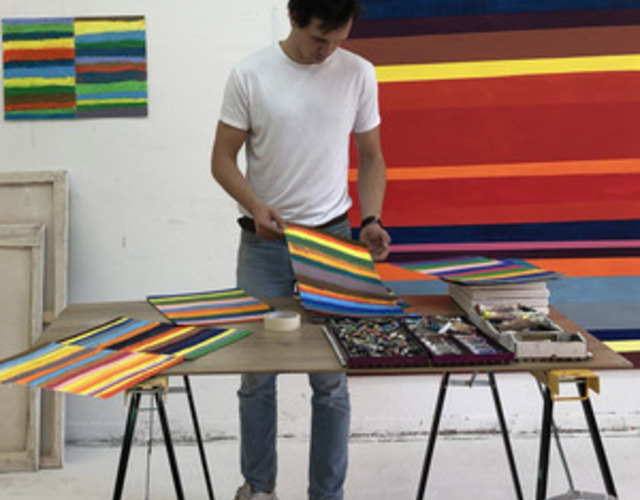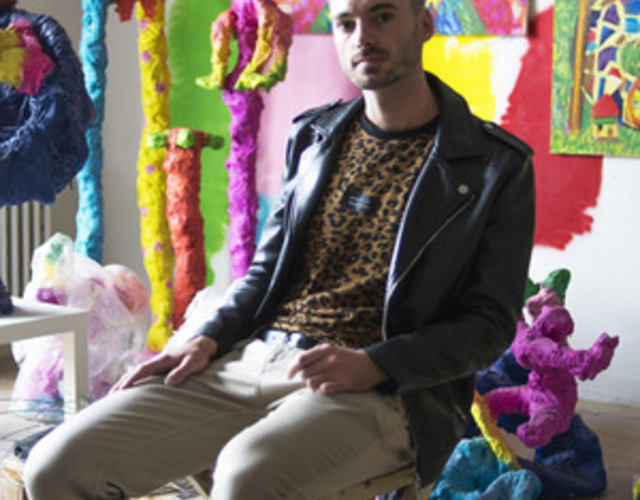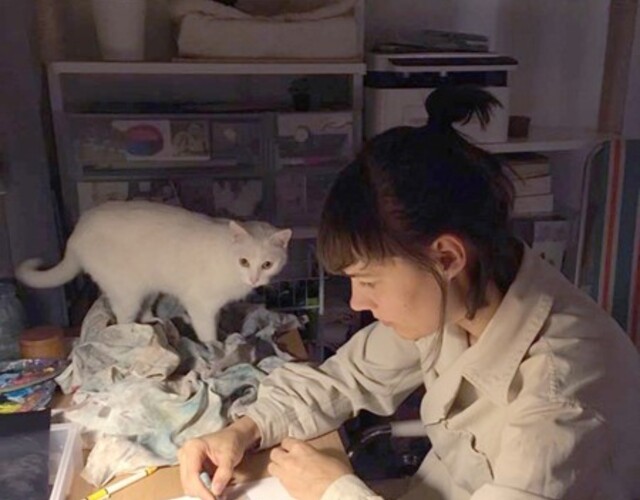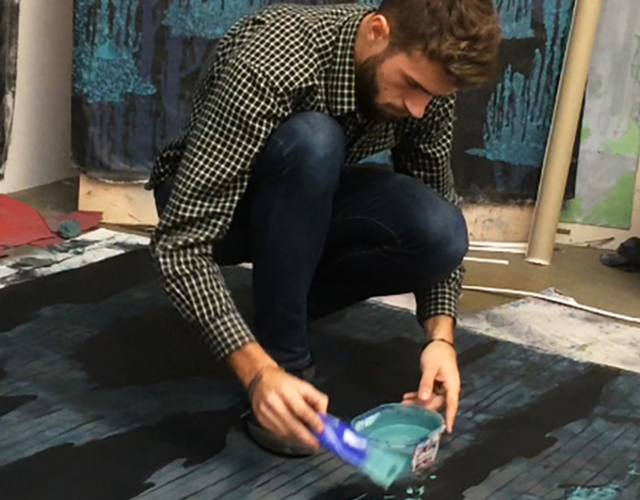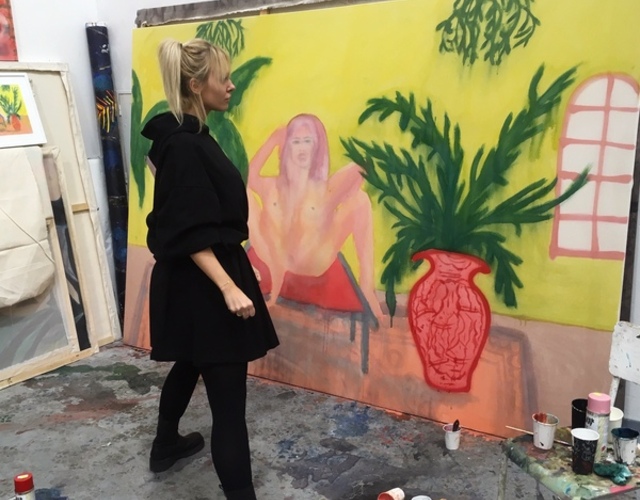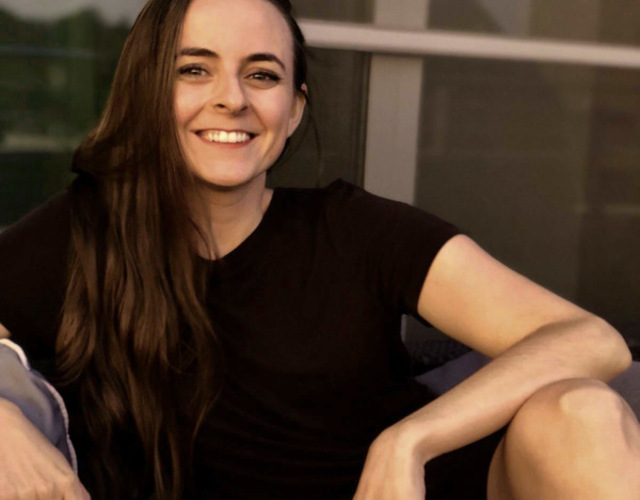Journey from the roots to the whale: over the paintings by Alžběta Rajchlová
Published 2024-11-11

A tiny young woman stands in front of a large-format painting in what may be referred to as "a girl´s power stand": firm yet flexible, elbows bent, chin down and gaze turned towards the viewer in confident expectation. Quite a striking staging of "a portrait of a painter" – Alžběta Rajchlová. The hidden energy that the image reveals can only really be understood properly by observing Alžběta's work as a whole.
The delicately modelled shapes that dominate her paintings are obviously of organic nature, derived from the images of cells, single-celled organisms, nerve and muscle or plant fibres, soft spongy formations and tough bulbs and roots that due their growth permeate their environment continuously, but also cellular clusters, embryonic formations that seem to be transformed into a yet indeterminate but most probably a much more complex entity. What we observe here is the potential for growth, further development and transformation – or the very process of it - , intermingling, mixing, even uncontrollable exuberance (Next Door, 2022, Eye of Heaven, Heart of the World, 2020). This multiplicity inevitably leads the perceiver to try to liken what is depicted to shapes and objects familiar from their own experience, to symbolic meanings related to cultural tradition and its superficial knowledge.
The artist has taken the "girl´s power stand" before the painting Exuberance (2021), in which the formations that refer to female corporeality and procreation, to the process of physical development of the individual and its symbolic meanings are either connected in a symbolic way or separated in an explicit one: the dark figure similar to the Venus of Věstonice seems to have been left with the umbilical cord, from which a glowing embryo is released that continues its development in a swirling upward movement. While the placenta melts away at the bottom, the liberated womb flows through space like a jellyfish or manta ray in the sea water in the vicinity of coral fish: all these living and birthing organs and beings seem to float in the mother waters of the world.
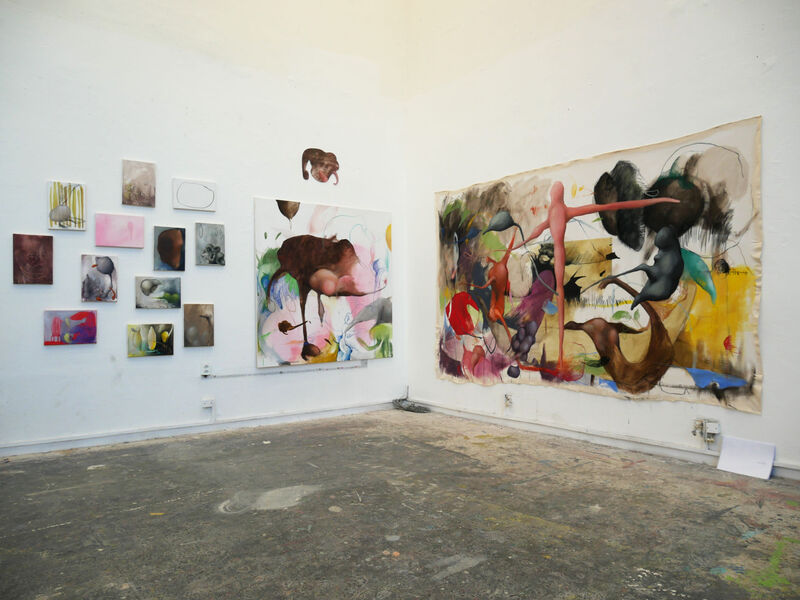
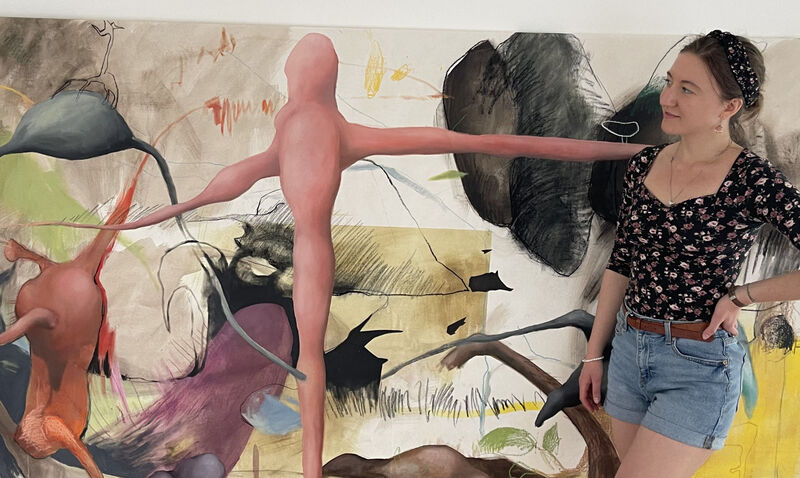
It has to be admitted that individual shapes sometimes stand out on their own from Alžběta's paintings, clearly separated from others by their shape or highlighted by colour. More frequently are they connected to their surroundings, most importantly, they never appear static. What is primarily depicted is the mode of existence of these organic formations: they make us wonder how they take in nutrients, how they grow, adapt to their surroundings or expand their sphere of life, how they move. Recently, the artist herself has promoted this effect on the recipient verbally – introducing titles of her works, in which an ongoing, past or anticipated event is announced – suggesting the perceiver to infer the implications and possible consequences of these events. However, she leaves the recipients in fundamental uncertainty as to who or what the agents of these events are (They flock to the lake, 2023, They searched until they found each other, 2024, In a second will they have gone, 2024). In her previous work, she used to leave her works largely untitled (with the exception of her oneiric episode indicating the presence of indefinite figures (for example, That Lullaby, That Dream, 2022).
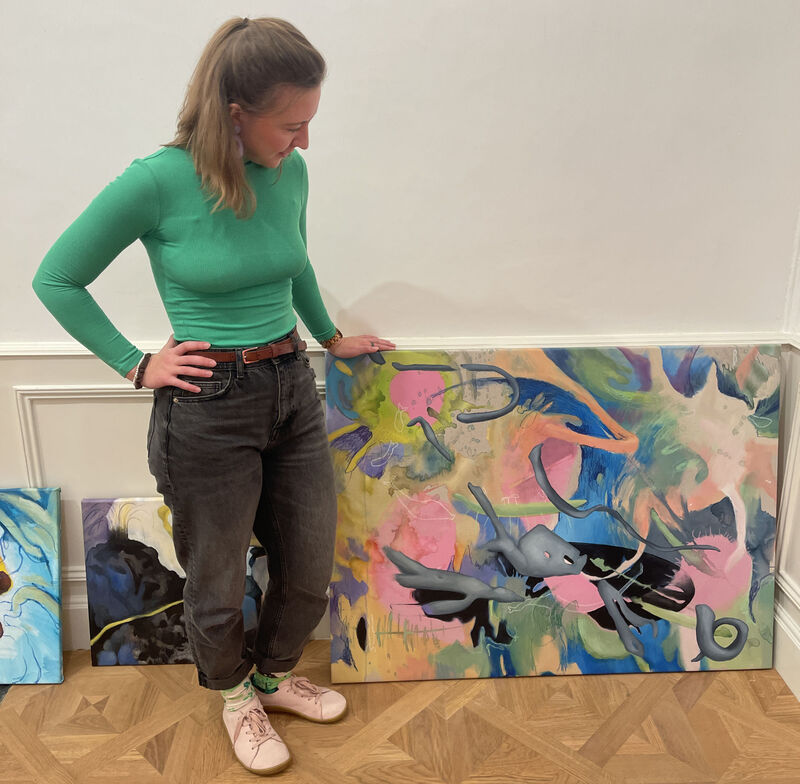
The New Zealand artistic residence is clearly imprinted in Alžběta´s recent work. It is not only in references to the multiplicity of marine life, but also in the awareness of the vastness and volume of this element, as suggested by the series In the Deep (2023). Here, both the vivid colours of sea sponges uprooted by the tide and the darkened hues of wilting seaweed appear as an echo of the rippling and waving of underwater groves. The tiny representatives of the marine flora may evoke the New Zealand author Katherine Mansfield's short story At the Bay (1921), win which the algae-covered rocks look like “shaggy beasts come down to the water to drink“ at low tide, while miniature underwater forests of anemones ripple in pools of seawater, surrounded by the mottled rocks of formed by other tiny creatures.
Alžběta´s work includes also paintings that do not feature growth and proliferation but the contrary – decomposition of roots or trunks, their absorption by other natural substances (Eye, Sky, Heart of the World, 2020; Untitled, 2021). The Czech recipient may be also reminded of images the effect of which the opposite of Mansfield's – to mental images of natural phenomena induced by the naturalistic descriptions of of the Czech novelist Josef Karel Šlejhar. So does his short story Bay of Death (1910) that evokes the anxious feeling of the inevitable dying of all living things, visceral reluctance. Alžběta´s painting Inside (2020) seems to have been painted to illustrate Šlejhar´s short story The Funeral (1910), in which the protagonist, in despair over the death of her child, flees her home. In a grove, she stops at a tall gnarled oak tree whose “black cavity was sinking somewhere inward", while the fungi seemed to "emerge from the smouldering of life in an overflow ": the vividly described examples of organic decay and the process of transformation of matter take on symbolic meanings here.
Despite its distinctive, truly unique morphology, Alžběta's work is not prone to monotony: this is evidenced, for example, by the series Tribes (2022 at the NTK Gallery, in the exhibition Hungry empty ghost), which, both in its elongated format and in the contrast of finely applied acrylic with the modelling mass of oil, suggests a fusion between modernist japonerie and a surrealist vision of the world, represented by enigmatic levitating objects.
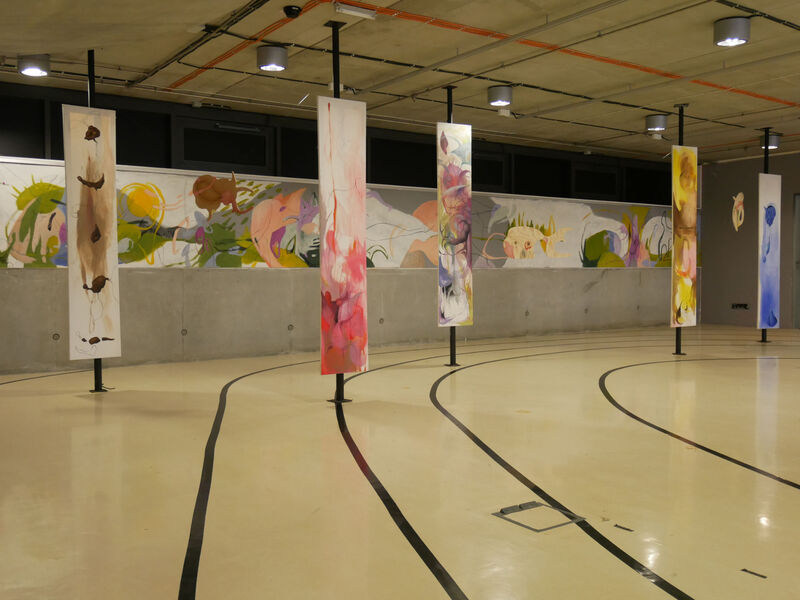
The Journey to the Whale, a pair of large-format paintings created for the Art Prague 2024 exhibition, encompasses many thematic components of Elizabeth's previous work: baggy formations resembling internal organs; the vigorous growth of sea sponges; individual fragile, fading or current-borne corals – beings threatened with extinction; spiky shapes that we might associate with both new shoots and dangerous spines; the ribs of a massive creature, which resembles more the famous skeleton exhibited in the National Museum of Prague rather than a living whale; and amongst all this, anthropomorphic shapes that suggest the presence of a female being – a mermaid or a brave diver maybe. All this reminds us of the interdependence of the biosphere. However, we can also perceive both paintings synaesthetic mode – and understand the rippling of water masses and objects as the visualization of the sounds of a whale song.
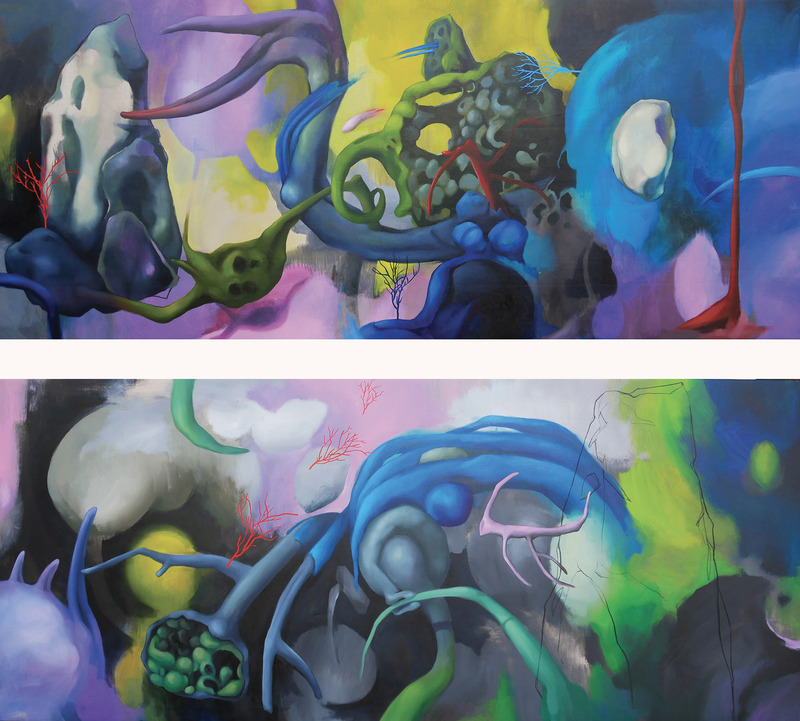
Some of Alžběta´s more display a slight change in style: the clearly delimited shapes seem to give way to air or fire-entwined "fabric". We shall see if 'they will have gone in short”. Rather, we can expect the painter's connection to the elements of our world – earth, water, wood and flesh – to endure, and to resist the challenge in the title of one of her more recent paintings – Tear Out (2024). For – without the owners of the paintings noticing – these intertwined roots, bulbs, tubers and fibres quietly continue to grow, secretly nourished by the unfading energy of their creator.
Alice Jedličková
